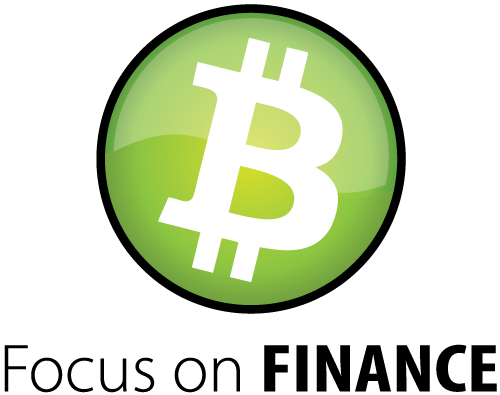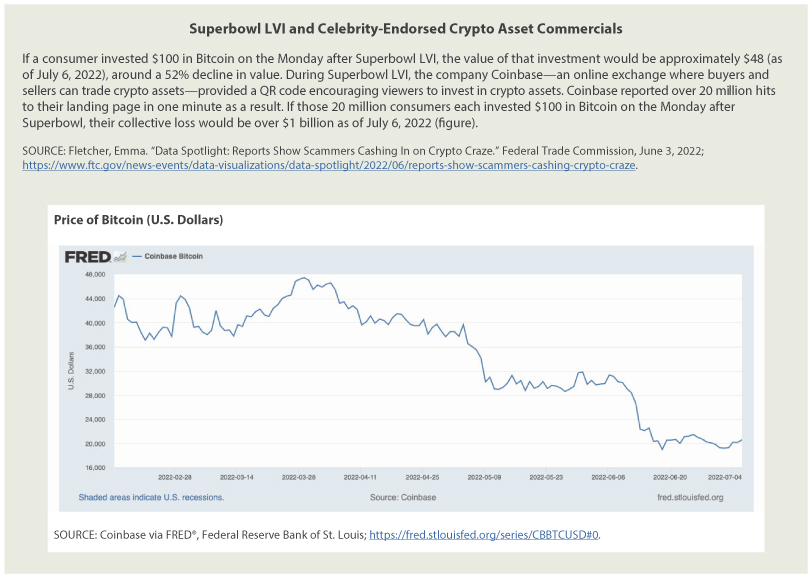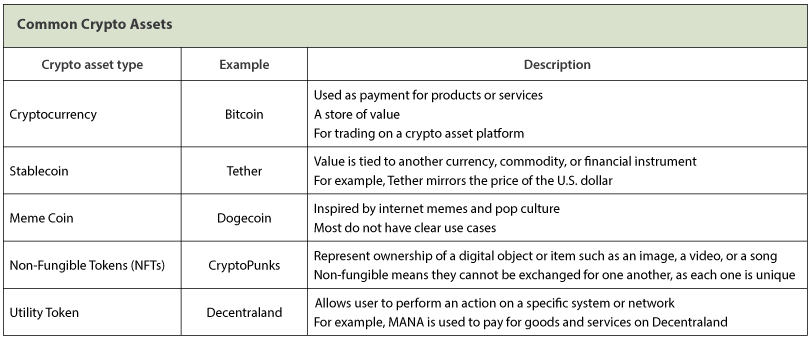Beyond the Hype: An Introduction to Crypto Assets

"Know what you own and know why you own it."
—Peter Lynch1
Celebrities, athletes, and social media influencers frequently promote crypto assets as a financial investment too good to miss. The fear of missing out, commonly abbreviated as "FOMO," has become a prominent term in the glossary of crypto asset jargon. Expectations that a crypto asset's value as a financial asset will skyrocket "to the moon" have fueled increased interest among the general public.
During Superbowl LVI, one of the most-watched television broadcasts in the United States, multiple commercials promoting crypto asset companies occupied coveted airtime. This reflects digital assets' rise as a cultural phenomenon in American society and, equally, corporations' desire to cultivate new crypto asset enthusiasts. (See boxed insert, "Superbowl LVI and Celebrity-Endorsed Crypto Asset Commercials.") With all the information circulating on the internet and across social media, let's look beyond the hype.

What Are Crypto Assets?
Crypto assets are digital assets. In recent years they have been more frequently held as risky financial investments with the expectation their value will rise. For an investment, the risk is the chance of loss. Bitcoin, a cryptocurrency (one type of crypto asset), is the first successful crypto asset created. Bitcoin built upon innovations from previous, failed attempts to rise as the most well-known and largest crypto asset today.
Crypto asset market capitalization is the total dollar value of a crypto asset. In November 2021, market capitalization for all crypto assets reached an all-time high of approximately $2.9 trillion.2 By June 2022, the value of all crypto assets dropped by nearly $2 trillion. Bitcoin is considered one of the most stable crypto assets yet lost almost 70% of its value during this same period. Some investors, like Microsoft founder Bill Gates, are skeptical about crypto assets as investments: "I like investing in things that have valuable output. The value of companies is based on how they make great products. The value of crypto is just what some other person decides someone else will pay for it so [it's] not adding to society like other investments."3
While the value of digital assets as an investment is the subject of ongoing debate, financial regulators are increasingly using the term "crypto assets" rather than "cryptocurrencies" to broadly define these digital assets. (NOTE: A full discussion of the value of crypto assets as a form of money is outside the scope of this article.)
Where Do Crypto Assets Come From?
Building Blocks of Crypto
1. Distributed Ledger
To understand the crypto asset market, it is valuable to have some knowledge of the underlying technology behind Bitcoin and why it was created. This technology, known as blockchain, is a digital ledger. A ledger in its basic form is a recording of economic activity and financial relationships. When Bitcoin users buy, sell, and store Bitcoin, this information is logged on a single, public blockchain ledger recording ownership.4
These transactions must be validated, which is accomplished by "miners." These miners form a distributed network of powerful computers around the world that complete complex mathematical problems to verify transactions. Miners can be viewed as auditors of Bitcoin transactions and are paid for this work in new Bitcoin. Verified transactions are packaged into blocks, with each block containing a reference to the previous one, linking them together in a long chain—hence the term "blockchain."5
2. Decentralized Database
The Bitcoin blockchain is located in a decentralized computer network. That is, no data are stored in a central location, and, instead, information is distributed across the network. There is no central authority or governing body with control of the network. The anonymous creator of Bitcoin was motivated by the desire to have a system independent from the influence of any governing body. Unlike digital payment systems such as Zelle or PayPal, a Bitcoin blockchain allows users to buy, sell, and store the crypto asset without an intermediary such as a bank. It effectively "cuts out the middleman" by allowing users to make transactions directly with other users, also known as "peer-to-peer." In addition, since no one authority has control, the network is public, and users can access it at any time.
3. Cryptographic Technology
"Crypto" is derived from the Greek word "kryptós," meaning "hidden." Cryptography provides methods to send secure messages between participants. Blockchain crypto assets rely on cryptographic methods to maintain the security of transactions independent of a central authority. Like a real-world signature, blockchain uses encryption keys that ensure the authenticity of the transaction of the user.6
Why Are There So Many Crypto Assets?
The introduction of blockchain technology has allowed developers to create a multitude of crypto assets. Building upon Bitcoin's blockchain, these other crypto assets have similar blockchains that are programmed for different use cases. Just as Instagram and Twitter are both social media platforms but configured for different purposes, each crypto asset has a different design and intended purpose. The table gives examples of common crypto asset types.

How Large Is the Crypto Asset Market Compared With Global Financial Markets?
Financial markets bring buyers and sellers together to trade stocks, bonds, currencies, and other financial assets, including crypto assets. In 2021, the global stock market value was $124.4 trillion. In that same year the global bond market value totaled $126.9 trillion.7 In comparison, the highest total crypto market capitalization was $2.9 trillion (November 2021).8 While crypto assets have been at the forefront of news stories in recent years, they remain a small fraction of global stock and bond markets. It's important to remember crypto assets are still relatively new and that time will tell how the crypto asset market evolves.
Beware of Scams
The increased popularity of crypto assets has also brought an increase in fraudsters looking to lure investors into scams. In June 2022, the Federal Trade Commission reported scammers had stolen over $1 billion in crypto from 46,000 people since the start of 2021. This amounts to about a quarter of all reported losses to fraud for this period.
Those 20-49 years of age are three times more likely to lose crypto to scammers than are older age groups. Nearly half the people who reported losing crypto to a scam said it started with an ad, a post, or a message on a social media platform. Overwhelmingly, most crypto scam losses reported during this period were from fake investment opportunities, promising huge returns for investors. In 70% of the reported losses to crypto scams, Bitcoin was the crypto asset used to pay scammers.9
It's important to remember that crypto asset transactions can't be reversed; once it's gone, there's no getting it back.
Are Crypto Assets Regulated?
The crypto market is under the microscope of financial authorities. Federal agencies have signaled their plans to increase supervision and enforcement of the crypto market. For example, the U.S. Securities and Exchange Commission (SEC), a federal agency charged with protecting investors, announced in May 2022 it is doubling the size of its Crypto Assets and Cyber Unit within its Enforcement Division.10
In addition, President Biden issued an executive order in March 2022 outlining an approach to addressing the risks and potential benefits of crypto assets. The order outlined six priorities, including consumer and investor protection.11
While regulations around crypto assets, including investor protection, will continue to evolve, crypto assets are currently not subject to the same level of supervision as traditional asset classes. Gary Gensler, Chair of the SEC, has offered the following advice to potential investors: "To those currently or considering investing in crypto, please remember: Not only are they a highly speculative asset class, but there are also significant gaps in the investor protection afforded to you."12
Considerations Before Investing
Never Invest More Than You Can Afford
According to Lori Schock, Director of the SEC's Office of Investor Education and Advocacy, "A good rule of thumb when investing in a new product is to only invest money that you are willing to lose, so that it's not financially devastating if the investment doesn't pan out."13
Be Careful Where You Get Your Advice
The SEC has issued statements urging caution around celebrity-endorsed crypto assets, including the following:
Investors should note that celebrity endorsements may appear unbiased, but instead may be part of a paid promotion. Investment decisions should not be based solely on an endorsement by a promoter or other individual. Celebrities who endorse an investment often do not have sufficient expertise to ensure that the investment is appropriate and in compliance with federal securities laws.14
(See boxed insert, "Celebrity Endorsement: Good for the Consumer or the Celebrity?")

Conclusion
While initially introduced as a payment system, crypto assets are seen by many as an enticing investment opportunity. Blockchain technology is an important milestone in how economic and financial transactions are recorded. This technology has helped spur the development of thousands of crypto assets for a wide range of use cases. Bitcoin has the greatest longevity as the first successful crypto asset, yet it has experienced a significant recent decline in value.
Traditional financial assets like stocks have regulations that protect investors from potential fraud. However, crypto assets do not have these same protections and have significant gaps in regulation. Consumers should thoroughly investigate crypto assets they are considering, safeguard themselves from scams, and only invest money in crypto assets they can afford to lose.
Notes
1 Lynch, Peter. One Up on Wall Street. New York: Simon & Schuster, 2012.
2 CoinMarketCap. "Total Cryptocurrency Market Cap." Global Cryptocurrency Charts, https://coinmarketcap.com/charts/.
3 Sandler, Rachel. "Bill Gates Explains Why He Doesn't Own Any Cryptocurrency." Forbes, May 19, 2022; https://www.forbes.com/sites/rachelsandler/2022/05/19/bill-gates-explains-why-he-doesnt-own-any-cryptocurrency/.
4 Andolfatto, David and Martin, Fernando M. "The Blockchain Revolution: Decoding Digital Currencies." Federal Reserve Bank of St. Louis Review, 2022, 104(3), pp. 149-65; https://research.stlouisfed.org/publications/review/2022/07/14/the-blockchain-revolution-decoding-digital-currencies.
5 Bank of England. "What are Cryptoassets (Cryptocurrencies)?" KnowledgeBank, May 19, 2020; https://www.bankofengland.co.uk/KnowledgeBank/what-are-cryptocurrencies.
6 Seth, Shobhit. "Explaining the Crypto in Cryptocurrency." Investopedia, May 15, 2022; https://www.investopedia.com/tech/explaining-crypto-cryptocurrency/.
7 Securities Industry and Financial Markets Association. "2022 Capital Markets Fact Book." SIFMA, July 2022; https://www.sifma.org/wp-content/uploads/2022/07/CM-Fact-Book-2022-SIFMA.pdf.
8 CoinMarketCap. See footnote 2.
9 Fletcher, Emma. "Data Spotlight: Reports Show Scammers Cashing In on Crypto Craze." Federal Trade Commission, June 3, 2022; https://www.ftc.gov/news-events/data-visualizations/data-spotlight/2022/06/reports-show-scammers-cashing-crypto-craze.
10 U.S. Securities and Exchange Commission. "SEC Nearly Doubles Size of Enforcement's Crypto Assets and Cyber Unit." SEC Press Release, May 3, 2022; https://www.sec.gov/news/press-release/2022-78.
11 The White House. "Executive Order on Ensuring Responsible Development of Digital Assets." Presidential Actions, March 9, 2022; https://www.whitehouse.gov/briefing-room/presidential-actions/2022/03/09/executive-order-on-ensuring-responsible-development-of-digital-assets/.
12 U.S. Securities and Exchange Commission. "Crypto Assets." SEC Investor.gov, https://www.investor.gov/additional-resources/spotlight/crypto-assets.
13 Schock, Lori. "Thinking About Buying the Latest New Cryptocurrency or Token?" SEC Investor.gov, https://www.investor.gov/additional-resources/spotlight/directors-take/thinking-about-buying-latest-new-cryptocurrency-or.
14 U.S. Securities and Exchange Commission. "SEC Statement Urging Caution Around Celebrity Backed ICOs." SEC Division of Enforcement and SEC Office of Compliance Inspections and Examinations, November 1, 2017; https://www.sec.gov/news/public-statement/statement-potentially-unlawful-promotion-icos.
© 2022, Federal Reserve Bank of St. Louis. The views expressed are those of the author(s) and do not necessarily reflect official positions of the Federal Reserve Bank of St. Louis or the Federal Reserve System.
Glossary
Asset: A resource with economic value that an individual, corporation, or country owns with the expectation that it will provide future benefits.
Risk: The chance of loss.


 follow @stlouisfed
follow @stlouisfed